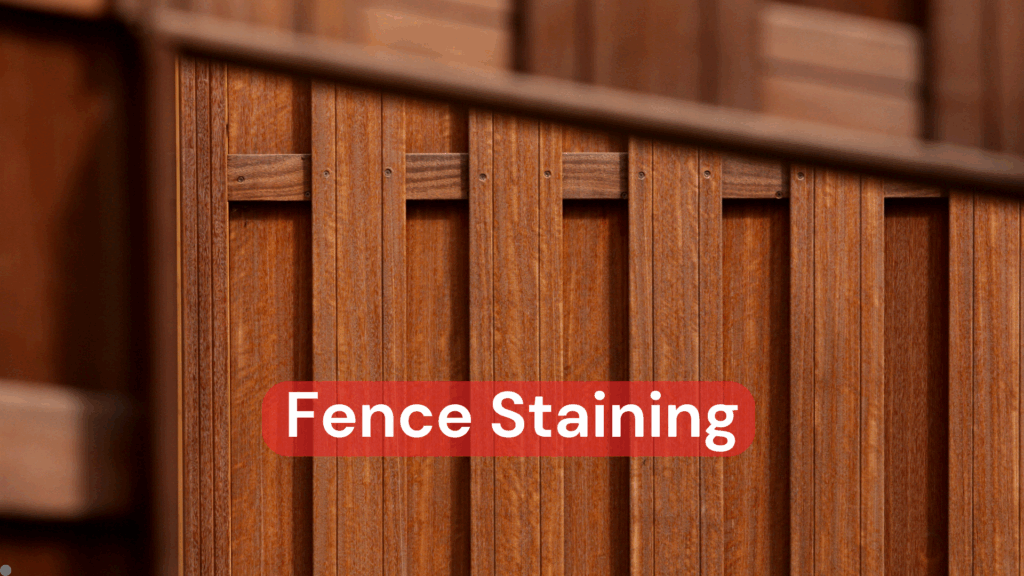Fence staining protects your wooden fence from rot, warping and UV light through cold Canadian winters and hot summers. Understand the upkeep.

Your wooden fence has its work cut out for it in Canada’s brutal climate, and without proper protection, it’s fighting a losing battle. Freeze-thaw cycles, driving rain, and scorching UV rays can reduce an untreated fence to weathered grey boards in just a few seasons. Fence staining creates a protective barrier that shields wood from damage – but the process involves more than simply brushing on a coat of stain. It requires careful preparation, proper materials, and precise application to create lasting protection against Canada’s extreme weather conditions.
Is your fence ready to face another wicked winter or smoking hot summer?
Table of Contents
Why Fence Staining is Vital for Canadian Homeowners
Rain and melting snow seep into untreated wood, creating perfect conditions for rot and mould growth. Summer’s intense UV rays dry out the wood fibres, causing cracks, splits, and fading that weaken the structure. The sun’s UV rays break down lignin – the natural binder in wood – accelerating fibre degradation.
A quality stain creates a protective barrier that repels moisture while blocking harmful UV radiation. This shield prevents water from penetrating deep into the wood grain, stopping rot before it starts. The stain also maintains the wood’s natural flexibility, reducing the cracking and warping that occurs when untreated lumber expands and contracts with temperature changes.
The Impact of Harsh Canadian Weather
Cities like Calgary, Kelowna, Edmonton, and Hamilton experience dramatic seasonal shifts that test wooden fences to their limits. Harsh winters with freezing temperatures and heavy snow can cause wood to contract, crack, and warp, while wet springs bring moisture that leads to rotting if the wood absorbs water.
The freeze-thaw cycle poses the greatest threat. When moisture trapped in wood fibres freezes, it expands. As temperatures rise, the ice melts and contracts. This repeated expansion and contraction weakens the wood structure, creating cracks that allow more moisture to penetrate. This process can also loosen fence posts, making them wobbly and unstable.
Summer heat compounds the problem. Intense UV rays bleach the wood’s natural colour and break down lignin—the substance that binds wood fibres together. Without protection, your fence becomes brittle and prone to splitting.
Proper sealing through staining prevents moisture infiltration and UV damage, maintaining the wood’s structural integrity through every season.
Key Steps to Effective Fence Staining
Professional fence staining involves multiple stages that require skill, patience, and attention to detail. The process starts with thorough assessment and preparation, moves through careful material selection, and concludes with precise application techniques. Skipping steps or rushing the process compromises the final result and shortens the stain’s protective lifespan.
Thorough Cleaning and Preparation
Cleaning removes dirt, mildew, old stain residue, and other contaminants that prevent new stain from adhering properly. A pressure washer effectively removes surface grime, but the water pressure must be carefully controlled to avoid damaging the wood fibres.
After cleaning, the fence must dry completely – typically 48 hours minimum. Rinse thoroughly and allow the fence to dry for at least 48 hours before staining. Using a moisture meter ensures the wood has a moisture content of 12% or less before staining. Applying stain to damp wood traps moisture beneath the surface, leading to peeling and premature failure.
Rough or splintered areas require sanding to create a smooth surface. This extra preparation step improves stain penetration and creates a more professional finish.
Selecting the Right Supplies and Stain Type
Oil-based stains offer superior durability and weather resistance for Canadian conditions. Oil-based stains are known for their exceptional durability, surpassing the longevity of water-based stains in most settings. They penetrate deeper into the wood grain and can last 4 years or more between applications.
Water-based stains dry faster and offer easier cleanup, but they typically require more frequent reapplication. Water-based stains also repel mold and mildew more effectively due to quick drying time. For fences exposed to harsh Canadian weather, oil-based products provide better long-term value.
Application tools matter too. Natural bristle brushes work best with oil-based stains, while synthetic brushes suit water-based products. Rollers speed application on smooth surfaces, but brushes ensure better penetration into wood grain.
Safety equipment includes gloves, eye protection, and adequate ventilation when working with oil-based products.
Application Methods and Drying Times
Proper application requires working systematically across fence sections, maintaining a wet edge to avoid lap marks. Apply stain in the direction of the wood grain, ensuring even coverage without over-application that leads to drips and uneven colour.
Temperature and humidity affect drying times significantly. Oil-based stains typically require 24 hours between coats, while water-based products may be ready for a second coat in 4-6 hours. However, cool temperatures or high humidity can extend these times considerably.
Most fences benefit from two coats of stain for optimal protection. The first coat penetrates the wood, while the second creates a protective surface layer.
Maintaining Your Stain for Long-Term Benefit
Regular inspection helps identify problems before they become serious. Check for peeling, fading, or areas where the stain has worn thin, particularly on south-facing sections that receive the most UV exposure.
Touch up small problem areas promptly to prevent moisture infiltration. A small repair now prevents major restoration work later.
Use a moisture meter annually to ensure wood moisture content stays below 12%, preventing stain failure. Experts recommend re-staining every 2–3 years to maintain optimal protection. This schedule maintains continuous protection and keeps your fence looking its best.
Improving Home Value and Aesthetics with a Maintained Fence
A well-maintained fence significantly impacts your property’s curb appeal and market value. According to real estate professionals, well-maintained outdoor spaces can add 5–12% to your property’s resale value.
Potential buyers notice exterior details immediately. A weathered, grey fence suggests neglect and raises questions about overall property maintenance. In contrast, a properly stained fence demonstrates pride of ownership and attention to detail.
Beyond resale value, a maintained fence enhances your daily enjoyment of your property. The rich, natural wood tones create an attractive backdrop for landscaping and outdoor activities.
Discover Endless Possibilities with Professional Painting Services
Harding’s Painting brings over 25 years of experience to fence staining and exterior painting projects. Our skilled teams serve homeowners in Calgary, Kelowna, Edmonton, and Hamilton, delivering professional results that stand up to Canadian weather conditions.
Our comprehensive approach includes thorough preparation, premium materials, and precise application techniques that maximize your stain’s protective lifespan. We understand local climate challenges and select products specifically suited to your region’s weather patterns.
Beyond fence staining, we offer complete painting services for residential and commercial properties, including exterior painting and renovation work.
Invest in Your Fence for Years of Lasting Protection and Beauty
Fence staining provides essential protection against Canada’s harsh climate while maintaining your property’s aesthetic appeal and value. The process requires careful preparation, quality materials, and precise application—factors that make professional service a wise investment for many homeowners.
A properly maintained fence serves your family for decades while contributing to your property’s overall appeal. Consider the complexity and time commitment of the staining process and the importance of long-lasting results when deciding between DIY and professional application. Canadian summers are only so long – you should enjoy your backyard while we take care of the nitty gritty.Contact Harding’s Painting to discuss your fence staining needs and explore how our experienced team can help protect your investment for years to come.



